How much predictability is there for these higher moments?
Data
The data consist of daily returns from the start of 2007 through mid 2011 for almost all of the S&P 500 constituents. Estimates were made over each half year of data. Hence there are 8 pairs of estimates where one estimate immediately follows the other.
What is more important than predicting actual values — at least for such applications as portfolio optimization — is predicting the rank within the universe. Hence looking at the Spearman correlation between estimates in different time periods is a reasonable test of the predictability that we care about.
Kurtosis
There’s good news and bad news.
Figure 1 shows the good news — there is statistically significant predictability in kurtosis.
The kurtosis estimates are in a matrix: 9 columns for different times and 477 rows for the assets. The steps of the permutation test were:
- Do 1000 times: permute the values within each column (so the values in any row of the permuted data are for different assets)
- Save the 8 correlations in sorted order from each of the permuted matrices
- Save the sorted correlations from the original data
This is then plotted in Figure 1. The boxplots show the distributions of the correlations from the permuted data (the boxplot at 1 is the distribution of the smallest correlations, the boxplot at 8 is the distribution of the largest correlations). The blue points show the actual correlations. The distribution of actual correlations is unambiguously larger than what would happen by chance.
Figure 1: Permutation test of Spearman correlation between contiguous pairs of kurtosis estimates, sorted — actual data are in blue. 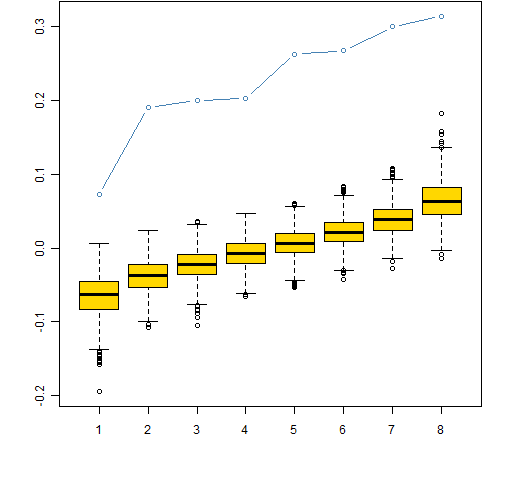
The bad news is that it seems doubtful that the predictability is of economic significance. Figure 2 shows the most recent pair of estimates. This looks typical but happens to be the one with the largest Spearman correlation. Figure 3 is the same data plotted on log scales.
Figure 2: Estimates of kurtosis for data starting mid 2010 and starting at the start of 2011. 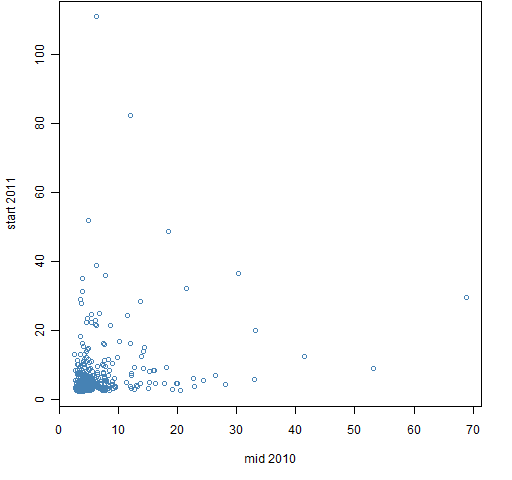
Figure 3: Estimates of kurtosis for data starting mid 2010 and starting at the start of 2011, log scales. 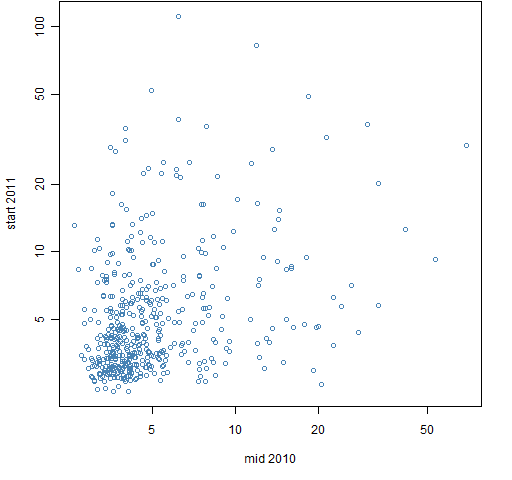 To give a sense of perspective, Figure 4 shows the corresponding data for volatility.
To give a sense of perspective, Figure 4 shows the corresponding data for volatility.
Figure 4: Estimates of volatility for data starting mid 2010 and starting at the start of 2011. 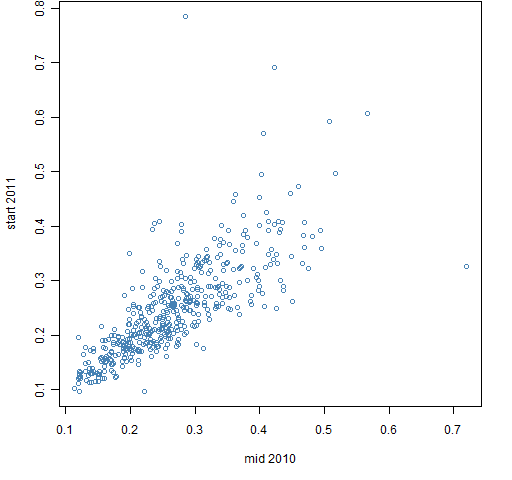
Skewness
Figure 5 shows the results of the permutation test on skewness estimates. The observed correlations look just like a typical result from the permuted data.
Figure 5: Permutation test of Spearman correlation between contiguous pairs of skewness estimates, sorted — actual data are in blue. 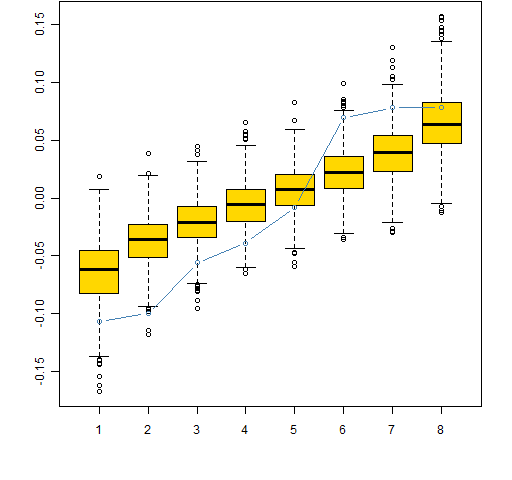
This does not prove that there is no predictability in skewness. It does, however, suggest that — just as with expected returns — looking for predictability based only on the past price history is unlikely to be fruitful.
Questions
What other ways are there to explore kurtosis and skewness?
Using a year rather than half a year of data seems to make little difference.
Appendix R
estimation
The first task is to create the matrices that will hold the estimates:
spHkurt <- spHskew <- array(NA, c(477, 9), list(colnames(spmat.ret)[-1], names(sp.breakr)[-10]))
Then the matrices are populated:
for(i in 1:9) spHkurt[,i] <- pp.kurtosis(spmat.ret[seq(sp.breakr[i], sp.breakr[i+1]), -1])
for(i in 1:9) spHskew[,i] <- pp.skew(spmat.ret[seq(sp.breakr[i], sp.breakr[i+1]), -1])
The reason that the first column of the returns data is dropped is because that column holds the returns for the index. (There is an off-by-one error in the seq commands above, but that is the code that was actually used.)
permutation test
The permutation tests are done with:
perm.spcorHkurt <- pp.corcolperm(spHkurt)
perm.spcorHskew <- pp.corcolperm(spHskew)
plot
Figure 1 was created by:
boxplot(perm.spcorHkurt$perms, col="gold", ylim=range(perm.spcorHkurt$perms, perm.spcorHkurt$statistic))
points(1:length(perm.spcorHkurt$statistic), perm.spcorHkurt$statistic, col='steelblue', type='b')
source code
The definitions of the skewness, kurtosis and permutation functions are in kurtskew.R
Update: the original version of this file had a bug in the function (the data were not properly centered). It was updated 2012-04-29. The numerical values in this post are off, but the patterns should be the same.

Pingback: More on higher moments: rolling skewness of S&P 500 daily returns | DataPunks.com
Pingback: A slice of S&P 500 skewness history | Portfolio Probe | Generate random portfolios. Fund management software by Burns Statistics
Pingback: How can higher co-moments be applied to portfolio optimization in an asset allocation context? | CL-UAT
Pingback: How can higher co-moments be applied to portfolio optimization in an asset allocation context? - Finance Money